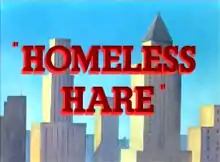Homeless Hare
Homeless Hare is a 1950 Warner Bros. Merrie Melodies cartoon short directed by Chuck Jones.[1] The short was released on March 11, 1950, and stars Bugs Bunny.[2]
| "Homeless Hare" | |
|---|---|
 | |
| Directed by | Charles M. Jones |
| Produced by | Edward Selzer (uncredited) |
| Story by | Michael Maltese |
| Starring | Mel Blanc John T. Smith (uncredited) |
| Music by | Carl Stalling |
| Animation by | Ken Harris Phil Monroe Ben Washam Lloyd Vaughan Emery Hawkins (uncredited) |
| Layouts by | Robert Gribbroek |
| Backgrounds by | Peter Alvarado |
| Color process | Technicolor |
Production company | |
| Distributed by | Warner Bros. Pictures |
Release date | March 11, 1950 (USA) |
Running time | 7 minutes 4 seconds |
| Language | English |
Plot
Bugs wakes up after a long night to find that a burly construction worker (whom Bugs derisively dubs "Hercules") has just shoveled up his rabbit hole near a highrise building being built. Bugs kindly asks Hercules to put his hole back, and Hercules pretends to comply, before he dumps Bugs and the dirt into the dump truck. Bugs angrily shouts "Hey, you big gorilla! Didn't you ever hear of the sanctity of the American home?" before another mound of earth falls on him and the truck hauls him away.
When Hercules exits the crane, Bugs calls him from the building under construction ("Yoo hoo! Hercules! Here's a message for ya!") dropping a brick on him (along with a telegram labeled "Eastern Onion" reading "Okay Hercules... You asked for it... Bugs Bunny"), then a steel girder, and then plays with the elevator controls while Hercules is inside the elevator. He accidentally breaks the controls, causing the elevator to fly off, and Hercules to fall into a pile of wet concrete.
Bugs then impersonates the project engineer and orders Hercules to make a high brick wall, followed by several attachments. Once done, Hercules is trapped at dizzying heights on a teeterboard. As Bugs removes the bricks from one end, Hercules on the other end strips off his clothes to save weight. This only works temporarily; by the time Bugs removes the last brick, Hercules is down to nothing but his underwear.
Hercules takes the fall, but suddenly manages to knock Bugs out temporarily with a steel girder, causing Bugs to dumbly "sleepwalk" through a harrowing series of moving girders and other objects. He finally regains his senses when he falls into a barrel full of water, then witnesses his nemesis bullying a shy employee, swiping his lunch and ordering him back to work. Infuriated, Bugs decides to put the goon out of commission once and for all ("Action, he says? Action he shall get."). Appropriating a red-hot rivet with pliers, Bugs takes a look at the posted floor plans for the building and finds his mark. He releases the rivet down a hole; it bounces around through an elaborate maze of objects and finally lands and burns through a rope holding up a giant steel casing which falls on top of Hercules (who echoes Candy Candido's radio catchphrase, "I'm feelin' mighty low"). Bugs' ultimatum: "Do I get my home back or do I have to get tough?" prompts Hercules to finally wave the white flag in defeat. The next shot is of the finished skyscraper, with a slight indentation in the middle. At the bottom, Bugs sits in his hole - the building has been built around it - and declares: "After all, a man's home is his castle."
Alternate edits
Some television broadcasts omit the shot of Bugs dropping a brick on Hercules' head.
Trivia
The Blue Ribbon release also removed the shorts original Bugs Bunny in card, joining only Hot Cross Bunny, Knights Must Fall & Rabbit Hood in this distinction.
See also
- List of Bugs Bunny cartoons
- No Parking Hare - a remake of this cartoon in 1954
References
- Beck, Jerry; Friedwald, Will (1989). Looney Tunes and Merrie Melodies: A Complete Illustrated Guide to the Warner Bros. Cartoons. Henry Holt and Co. p. 209. ISBN 0-8050-0894-2.
- Lenburg, Jeff (1999). The Encyclopedia of Animated Cartoons. Checkmark Books. pp. 58–62. ISBN 0-8160-3831-7. Retrieved 6 June 2020.
External links
| Wikiquote has quotations related to: Homeless Hare |
| Preceded by Mutiny On The Bunny |
Bugs Bunny Cartoons 1950 |
Succeeded by Big House Bunny |